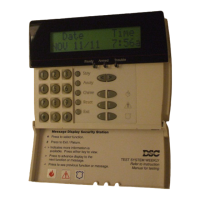P R O G R A M D E S C R I P T I O N S
33
5.10.2 PGM Output Attributes
In addition to programming the output type, you must also program the PGM output attributes for each output.
PGM output options [09] “System Trouble” and [10] “Latched System Event” have their own unique set of
attributes listed below the description of each output type.
PGM output options [01], [03], [05]-[08], [11]-[24] have the following attributes:
Attribute ON OFF
[1] Partition 1 controls event Partition 1 Does Not
[2] Partition 2 controls event Partition 2 Does Not
[3] True Output Inverted Output
The output energizes when activated The output will de-energize when activated.
(except for Option [03] Sensor Reset).
[4] 5 Second Pulse Output ON/OFF
The output will activate once for five The output will turn ON and OFF when initiated by
seconds when initiated by the user. the user
(only applicable to options [19] and [20]).
[5] Access Code Req. No code Req.
The output requires a code for activation. No code required.
(only applicable to keypad-activated outputs)
PGM attributes return to their default settings when you change PGM output options. Please see the
programming worksheets for a list of the default settings for each PGM output type.
Care should be taken in selecting the normal and active states of each PGM output to ensure that an
undesirable output state does not occur after a loss and restore of AC power.
Attribute [2], Partition 2 controls event is defaulted OFF for all output options.
Attribute [3] must be ON (default) for PGM output options [16], [23] and [24].
If you program more than one PGM output as the same output type (e.g. If PGM1 and PGM2 are both
programmed as [19] Command Output 1), the settings for output attributes [1], [2] and [5] must be the
same. This does not apply to outputs programmed as types [09] and [10].
○○○○○○○○○○○○○○○○○○○○○○○○○○○○○○○○
PGM Output Attributes ........................................... Section [141]-[142]
PC5208 Attributes .................................................. Section [143]-[150]
○○○○○○○○○○○○○○○○○○○○○○○○○○○○○○○○
PC5204 Attributes .................................................. Section [151]-[154]
5.11 Telephone Line Monitor (TLM)
When the TLM Enable option is selected, the panel will supervise the phone line and will indicate a
trouble condition if the phone line is disconnected.
If the TLM Enable option is ON, the panel will check the telephone line every 10 seconds. If the telephone
line voltage is below 3V for the number of checks programmed in the TLM Trouble Delay section, the panel
will report a TLM trouble. The default number of checks is 3. Enter a number from [003] to [255] in the TLM
Trouble Delay section to change the number of checks before the TLM trouble is reported. Programming a
delay means that a momentary interruption of the phone line will not cause a trouble condition.
If the TLM Trouble Beeps When Armed option is enabled, the panel will indicate a TLM trouble at the
keypad while the system is armed. To activate the bell output in the case of a TLM trouble while the
system is armed, the TLM Audible (Bell) When Armed option must be selected.
When the trouble condition is restored, the panel can send a TLM Restoral reporting code. Any events
which occur while the phone line is down will also be communicated.
If the LINKS1000 Cellular Communicator, or LINKS2X50 is being used, the panel can be programmed to
report a TLM Trouble Reporting Code.
Telephone Line Monitoring by the PC5700
The PC5700 module has the capacity to use two telephone lines. When the PC5700 module detects a
problem with the main line it will automatically switch to the secondary line. The secondary line will be
used by the panel until the problem with the main line is cleared. The PC5700 can detect the problem and
switch to the secondary line before the panel generates a TLM Trouble. Whenever the PC5700 detects a
problem on either line it will cause a tamper on module zone 8.
The PC5700 has two onboard LED’s that are used to indicate the current status of each of the telephone
lines. If a TLM Fault is detected on either line the appropriate LED will be on. When the switch located at
the top of the module is pressed and held, the LED’s corresponding to the last telephone line restored
from the trouble state will turn on. This function will only work if both lines are currently restored. The
LED’s will return to normal operation when the switch is released.
○○○○○○○○○○○○○○○○○○○○○○○○○○○○○○○○○○○○○○○○○○○○○
TLM Enable/Disable ....................................................................................... Section [015], Option [7]
TLM Trouble Beeps When Armed or TLM Audible (Bell) When Armed ....... Section [015], Option [8]
TLM Trouble Reporting Code ......................................................................... Section [349]
TLM Restoral Reporting Code ....................................................................... Section [350]
○○○○○○○○○○○○○○○○○○○○○○○○○○○○○○○○○○○○○○○○○○○○○
TLM Trouble Delay .......................................................................................... Section [370]

